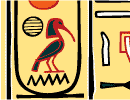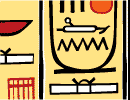|
Click Here to Create a Custom Cartouche of Your Name or Phrase with the Fun and Popular Hieroglyph Translator
HISTORY OF AKHENATEN
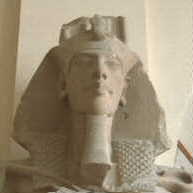 |
Reported by: Iain @ the Akhet Internet Site
Akhenaten was a Ruler of Egypt during the period known as the 18th
Dynasty. He ascended to the throne as Amenhotep IV, succeeding his father
Amenhotep III. Akhenaten's brief reign, only about 16
years, happened at a difficult time in Egyptian history and many scholars
maintain that Akhenaten was responsible for this decline, but evidence
suggests that it had already started.
Akhenaten, possibly in a move to
lessen the political power of the Priests, introduced the worship of one
god, the Aten, or Sun disk. The Pharaoh, not the
priesthood, was the sole link between the population and the Aten which
effectively ended the power of the various
temples. |
It is interesting to note that when Akhenaten's successors, the
generals Ay and Horemheb re established the temples of Amun they selected
their priests from the military, enabling the Pharaoh to keep tighter
controls over the religious orders.
The cult of the Aten is considered
by some to be a predecessor of modern
monotheism. |
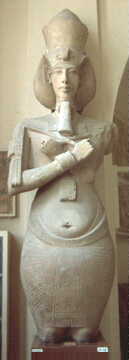 |
Not a Pharaoh to do things by half, when Akhenaten established his new
religion he built an entire city dedicated to the Aten. This city was
Akhetaten, the Horizon of the Aten. At the peak of
Akhenaten's reign over 20,000 people lived there. The city was built in
middle Egypt, on a site not tainted by the worship of other gods.
After the death of Akhenaten the city was abandoned, and the old
religions which had been suppressed quickly re-established their control
over Egypt. This return to the old ways may have been helped along by the
Pharaohs who followed Akhenaten, who allowed the priesthood to re
establish control. Akhenaten's immediate successor was Smenkhkare
about whom little is known, followed by Tutankhaten. Shortly after
gaining the throne Tutankhaten changed his name to Tutankhamun and moved
his capital from Akhetaten to Memphis. |
| Akhenaten is not credited with being a particularly successful
Pharaoh. Records seem to indicate that he allowed Egyptian influence wane,
but this may not be true as these ideas are based on the famous Amarna
letters found in Akhetaten. These letters show day to day
communication within the Egyptian empire and give a more detailed look at
events during Akhenaten's reign than we can obtain from other Pharaohs. In
most cases the information on different leaders comes from inscriptions
and paintings in their tombs, and if a Pharaoh was having problems abroad
this is hardly likely to be included with the decoration to remind him of
his difficulties in the afterlife. |
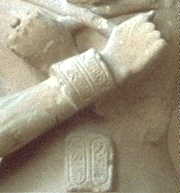 |
Later Pharaohs attempted to erase all memories of Akhenaten and his
religion. Much of the distinctive art of the period was destroyed and the
buildings dismantled. It is interesting to note that this was directed at
Akhenaten personally and not the Aten. In later dynasties it returned to
it's original position in Egyptian religion. |
The backlash against the religion of Akhenaten led to the
widespread destruction of his palaces and temples. Work began on
dismantling Akhetaten shortly after it was abandoned and, along with many
other of Akhenaten's monuments, it's stone was re-used by later Pharaohs.
Restoration work on the great pylons of Ramesses II at Karnak showed
that they used 'recycled' Aten temples for the filling. This has left
modern Archaeologists with the worlds biggest jigsaw puzzle. When the
Pylons were restored the filling was replaced with concrete. A section of
a temple wall has
now been restored and is on display in the Luxor
Museum. |
'Royal' Ring
 |
The Egyptian display in the NMS contains a section devoted to jewelry,
with many complex and beautiful items on show. Amongst these almost
unnoticed, lies potentially one of the most interesting and significant
items in the entire collection.
Several rings are on display from various sites, but one fine gold ring
could have once belonged to one of the most famous Queens in Ancient
Egypt, Nefertiti. This ring, bearing the Queens royal cartouche, was found
just outside the royal tomb at
Akhetaten in a small cache with some other jewelry.
|
Mysteries of Akhenaten | Timeline of Akhenaten
|
|

|

All trademarks and copyrights on this page are owned by their respective owners.
The Rest Copyright 1998-2012 All Rights Reserved www.Virtual-Egypt.com
|
|

|
|
Macromedia Flash
Hieroglyphic
Translator

Macromedia Flash
Hieroglyphic
Screen Saver

|
|
|
